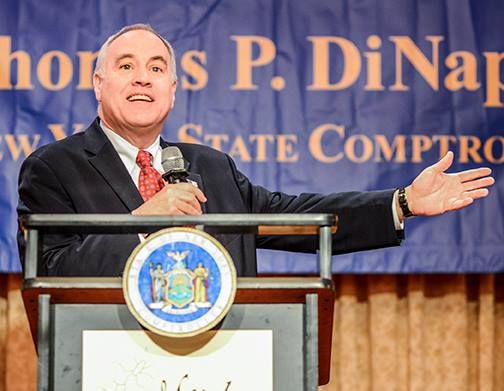
Town of North Hempstead officials are “committed” to keeping next year’s town budget within a lower state cap on property tax hikes, Supervisor Judi Bosworth said.
But the number has some North Shore villages wondering what a tighter cap for towns and counties will hold for them after grappling with the cap this spring.
“I’m a taxpayer too, so from that perspective I’m supportive and happy, but on the other hand I want to feel comfortable that we can still provide the necessary services required with the budget that we will have to appropriate,” Village of New Hyde Park Mayor Robert Lofaro said.
New York’s counties, towns, fire districts and other municipalities with fiscal years starting in January cannot increase the amount of money they raise through taxes by more than 0.68 percent in their 2017 budgets, the lowest since the property tax cap was implemented in 2012, State Comptroller Thomas DiNapoli announced last week.
The cap’s decrease from 0.73 percent for 2016 “will necessitate even tougher financial choices” in the tax cap’s sixth year, DiNapoli said in a statement. Low inflation has kept the cap tight for the past two years.
Passed in 2011 in an effort to lighten taxpayers’ burdens, the tax cap law says municipalities cannot hike their tax levies more than 2 percent or the rate of inflation, whichever is lower. The state comptroller’s office sets different caps for municipalities and school districts depending on their fiscal year.
North Hempstead officials are working to keep the town within the cap, as they did in 2015 and 2016, Bosworth said.
“It is indeed a challenge to put together a prudent fiscal plan for the Town under the .68 percent State tax cap, but I believe that we have a deep obligation to our residents to produce a budget that is fiscally responsible and stays within those parameters,” Bosworth said in a statement.
Nassau County Executive Edward Mangano said the law “continues to encourage local governments and school districts to pursue for efficiencies.”
But shrinking caps could put counties under stress if sales tax revenues continue their downward trend, Stephen J. Acquario, executive director of the New York State Association of Counties, in a statement.
The cap on village property tax hikes has yet to be released because all but 10 of them operate on fiscal calendars starting June 1 and ending May 31.
Villages grappled this year with 0.12-percent cap, well below the 0.73-percent hike allowed for towns and counties. The average homeowner in the Village of New Hyde Park, for example, saw a tax hike of $3.78, Lofaro said.
While 2017’s smaller cap for towns and counties does not necessarily mean villages will follow the same trend, they could have to find more non-tax revenues or cut services if they do, Lofaro said.
Both Lofaro and East Williston Mayor David Tanner said they support the tax cap’s goal of keeping taxes down. But the “generalized” measure of inflation the state uses does not account for expenses that usually drive village spending increases, Tanner said.
“They’re using an inappropriate inflation factor, so at some point the chickens are going to come home to roost, because you have other costs — you have these healthcare costs, you have these pension costs that are increasing at a faster rate,” said Tanner, a former president of the Nassau County Village Officials Association.






